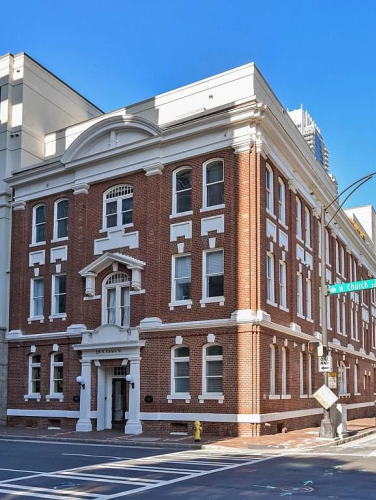
NC Medical College
(ca. 1907)
The birthplace of a popular restaurant, entrepreneurial incubator, and social hub for the West End’s African American community in the late twentieth century.
229 North Church St., Charlotte, NC 28202
The North Carolina Medical College building opened in 1907 to wide acclaim as the new home for a school founded in 1887 in Davidson by Dr. Paul B. Barringer (1857-1941). Originally the Davidson School of Medicine, the school was a proprietary institution, that is a profit-making organization dependent upon student tuition for income. Aspiring doctors had few medical school options in 19th-century North Carolina – Edenborough Medical College near Raeford (1867-1877), Leonard Medical School in Raleigh (1882-1914), and UNC-Chapel Hill (1879-1885) – leaving the training of most medical students to the tutelage of an established doctor. The Leonard Medical School, associated with the historically Black Shaw University, served only Black medical students. As a result, by the 1880s, North Carolina had no medical school for White students, making the Davidson School of Medicine all the more significant.
Property Quick Links
Dr. Barringer was the physician for Davidson College, but his medical school was unaffiliated with the college even though college faculty members also taught at the medical school under separate contractual arrangements. In 1889, when Barringer left Davidson College, he sold the medical school to Dr. John Peter Munroe, his replacement as the Davidson College physician. Under Dr. Munroe, the medical school became a three-year institution by 1893, the same year the school rechartered as the North Carolina Medical College. Despite continued grow, the school began sending its senior class to Charlotte in 1902 because the city’s numerous hospitals provided greater opportunities for clinical training. The entire student body moved to Charlotte with the 1907 completion of the North Church Street building.
The new three story red brick Colonial Revival style building included several classrooms for clinical lectures and demonstrations, a large lecture hall, five laboratories, a dissecting hall, a library, a pharmaceutical dispensary, separate waiting rooms for Black and White patients, several examination and treatment rooms (where free medical services were provided daily), and a large two-story amphitheater. Some 732 students attended the college, with 340 earning Doctor of Medicine degrees. However, the college was short-lived in Charlotte. A 1910 inspection and published evaluation by the Carnegie Foundation criticized the school’s inadequate facilities. Unwilling or unable to commit the necessary funds to bring the college into conformance with the Carnegie standards, Monroe and his associates closed the school in 1914, enrolling their remaining students at Richmond’s Medical College of Virginia. The North Church Street building was converted into luxury apartments in 1914.
James Mackson McMichael (1870-1944), a native of Harrisburg, Pennsylvania, who became a prolific local architect after his 1901 move to Charlotte, designed the North Carolina Medical College Building. Reported as having designed more than 900 churches in his 50-year career – including Charlotte’s Myers Park Presbyterian Church and First Baptist Church (now Spirit Square) – McMichael is widely regarded as one of North Carolina’s principal church architects. His houses of worship are scattered throughout the state, from Lincolnton to Edenton, and from Elizabeth City to Concord. His diverse body of work also included Charlotte’s Carnegie Library (formerly on North Tryon Street), Marion’s Marianna Hotel, Salisbury’s Cannon-Guille House, the Wilkes County Courthouse in Wilkesboro, and the Scotland County Courthouse and Jail in Laurinburg.

